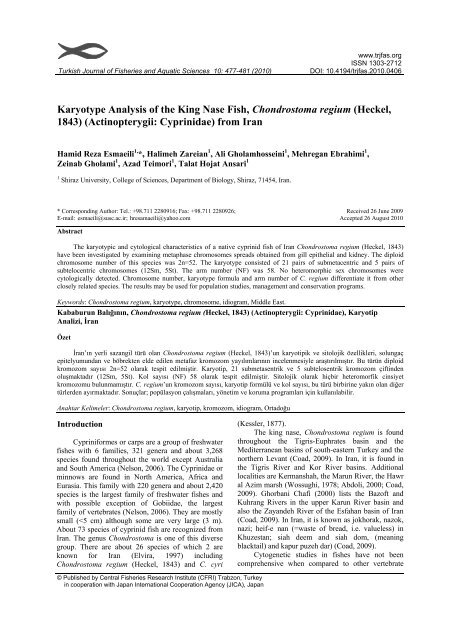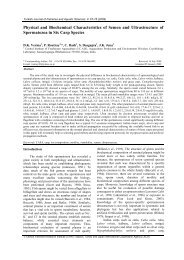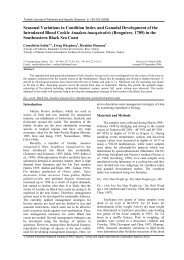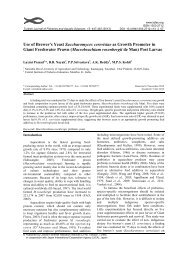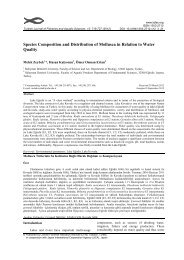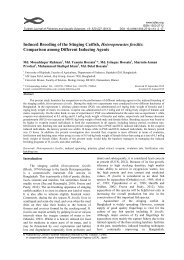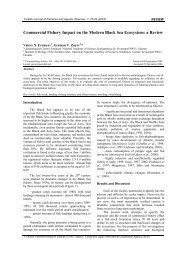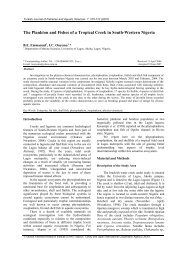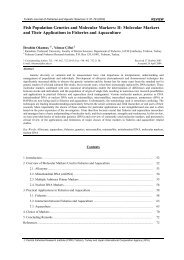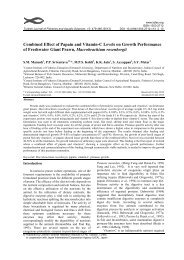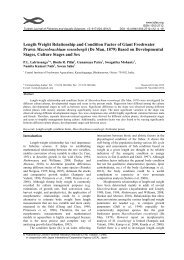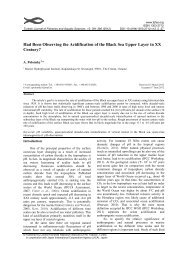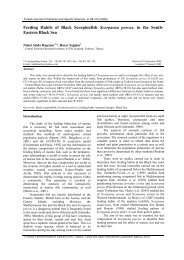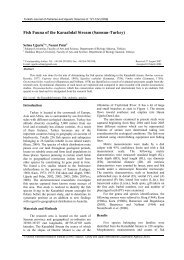Karyotype Analysis of the King Nase Fish, Chondrostoma regium ...
Karyotype Analysis of the King Nase Fish, Chondrostoma regium ...
Karyotype Analysis of the King Nase Fish, Chondrostoma regium ...
Create successful ePaper yourself
Turn your PDF publications into a flip-book with our unique Google optimized e-Paper software.
Turkish Journal <strong>of</strong> <strong>Fish</strong>eries and Aquatic Sciences 10: 477-481 (2010)<br />
www.trjfas.org<br />
ISSN 1303-2712<br />
DOI: 10.4194/trjfas.2010.0406<br />
<strong>Karyotype</strong> <strong>Analysis</strong> <strong>of</strong> <strong>the</strong> <strong>King</strong> <strong>Nase</strong> <strong>Fish</strong>, <strong>Chondrostoma</strong> <strong>regium</strong> (Heckel,<br />
1843) (Actinopterygii: Cyprinidae) from Iran<br />
Hamid Reza Esmaeili 1, *, Halimeh Zareian 1 , Ali Gholamhosseini 1 , Mehregan Ebrahimi 1 ,<br />
Zeinab Gholami 1 , Azad Teimori 1 , Talat Hojat Ansari 1<br />
1 Shiraz University, College <strong>of</strong> Sciences, Department <strong>of</strong> Biology, Shiraz, 71454, Iran.<br />
* Corresponding Author: Tel.: +98.711 2280916; Fax: +98.711 2280926;<br />
E-mail: esmaeili@susc.ac.ir; hresamaeili@yahoo.com<br />
Received 26 June 2009<br />
Accepted 26 August 2010<br />
Abstract<br />
The karyotypic and cytological characteristics <strong>of</strong> a native cyprinid fish <strong>of</strong> Iran <strong>Chondrostoma</strong> <strong>regium</strong> (Heckel, 1843)<br />
have been investigated by examining metaphase chromosomes spreads obtained from gill epi<strong>the</strong>lial and kidney. The diploid<br />
chromosome number <strong>of</strong> this species was 2n=52. The karyotype consisted <strong>of</strong> 21 pairs <strong>of</strong> submetacentric and 5 pairs <strong>of</strong><br />
subtelocentric chromosomes (12Sm, 5St). The arm number (NF) was 58. No heteromorphic sex chromosomes were<br />
cytologically detected. Chromosome number, karyotype formula and arm number <strong>of</strong> C. <strong>regium</strong> differentiate it from o<strong>the</strong>r<br />
closely related species. The results may be used for population studies, management and conservation programs.<br />
Keywords: <strong>Chondrostoma</strong> <strong>regium</strong>, karyotype, chromosome, idiogram, Middle East.<br />
Kababurun Balığının, <strong>Chondrostoma</strong> <strong>regium</strong> (Heckel, 1843) (Actinopterygii: Cyprinidae), Karyotip<br />
Analizi, İran<br />
Özet<br />
İran’ın yerli sazangil türü olan <strong>Chondrostoma</strong> <strong>regium</strong> (Heckel, 1843)’un karyotipik ve sitolojik özellikleri, solungaç<br />
epitelyumundan ve böbrekten elde edilen metafaz kromozom yayılımlarının incelenmesiyle araştırılmıştır. Bu türün diploid<br />
kromozom sayısı 2n=52 olarak tespit edilmiştir. Karyotip, 21 submetasentrik ve 5 subtelosentrik kromozom çiftinden<br />
oluşmaktadır (12Sm, 5St). Kol sayısı (NF) 58 olarak tespit edilmiştir. Sitolojik olarak hiçbir heteromorfik cinsiyet<br />
kromozomu bulunmamıştır. C. <strong>regium</strong>’un kromozom sayısı, karyotip formülü ve kol sayısı, bu türü birbirine yakın olan diğer<br />
türlerden ayırmaktadır. Sonuçlar; popülasyon çalışmaları, yönetim ve koruma programları için kullanılabilir.<br />
Anahtar Kelimeler: <strong>Chondrostoma</strong> <strong>regium</strong>, karyotip, kromozom, idiogram, Ortadoğu<br />
Introduction<br />
Cypriniformes or carps are a group <strong>of</strong> freshwater<br />
fishes with 6 families, 321 genera and about 3,268<br />
species found throughout <strong>the</strong> world except Australia<br />
and South America (Nelson, 2006). The Cyprinidae or<br />
minnows are found in North America, Africa and<br />
Eurasia. This family with 220 genera and about 2,420<br />
species is <strong>the</strong> largest family <strong>of</strong> freshwater fishes and<br />
with possible exception <strong>of</strong> Gobiidae, <strong>the</strong> largest<br />
family <strong>of</strong> vertebrates (Nelson, 2006). They are mostly<br />
small (
478 H. R. Esmaeili et al. / Turk. J. <strong>Fish</strong>. Aquat. Sci. 10: 477-481 (2010)<br />
groups in Iran (Kalbassi et al., 2008). In this respect,<br />
<strong>the</strong> most karyological studies in Iran consist <strong>of</strong><br />
Abramis brama (Nahavandi et al., 2001),<br />
Ctenopharyngodon idella (Nowruzfakhshami et al.,<br />
2002), Petroleuciscus persidis and Cyprinion<br />
tenuiradius (Esmaeili and Piravar, 2006a, 2006b),<br />
Iranocichla hormuzensis and Mastacembelus<br />
mastacembelus (Esmaeili et al., 2006a, 2006b),<br />
Schizothorax zarudnyi (Kalbassi et al., 2008),<br />
Aphanius spp. (Esmaeili et al., 2008) and Garra<br />
persica (Esmaeili et al., 2009). However<br />
<strong>Chondrostoma</strong> <strong>regium</strong> has been described and<br />
compared morphologically, but it's karyotype has not<br />
been investigated yet.<br />
As study <strong>of</strong> fish chromosomes has received<br />
considerable attention in recent years because <strong>of</strong> its<br />
usefulness in addressing problems <strong>of</strong> classification,<br />
evolution and heredity, this first report, could provide<br />
<strong>the</strong> detailed karyological features <strong>of</strong> this endemic carp<br />
from Iran.<br />
Material and Methods<br />
<strong>Chondrostoma</strong> <strong>regium</strong> specimens (Figure 1) were<br />
collected from Fahlian River (Figure 2), Nur Abad<br />
(Fars province, south, Iran) (30°11'06.2'' N.,<br />
51°31'27.9'' E., alt. 919 m) using electro fishing<br />
device and dip net. The o<strong>the</strong>r fish species including<br />
Copeta trutta, Copoeta aculeata, Barbus lutes,<br />
Barbus sublimus, Cyprinion macrostomum, Alburnus<br />
mossulensis and Barilius mesopotamicus Berg, 1932<br />
(Cyprinidae) and Nemacheilus sp. (Balitoridae) and<br />
Mastacembelus mastacembelus (Mastacembelidae)<br />
were also collected from this river. The fishes were<br />
transported live to <strong>the</strong> laboratory, and kept in a well<br />
aerated aquarium at 20-25°C before analysis. For<br />
karyological studies <strong>the</strong> modified method <strong>of</strong> Uwa<br />
(1986) was used. Colchicine solution was prepared<br />
with 0.005 g in 20 ml physiological serum. The fish<br />
were injected intraperitonally with 0.02 ml <strong>of</strong><br />
colchicine per gram <strong>of</strong> body weight using an insulin<br />
syringe, and <strong>the</strong>n were replaced in <strong>the</strong> aquarium for 4-<br />
5 hours. The gill filaments and kidneys <strong>of</strong> <strong>the</strong>se<br />
specimens were <strong>the</strong>n removed and placed in<br />
hypotonic 0.36% KCl solution for 45 min. at room<br />
temperature (25°C). Thereafter, <strong>the</strong> solutions were<br />
centrifuged for 10 min at 1000 rpm, adding 2-3 drops<br />
<strong>of</strong> fresh and cold Carnoy fixative (1:3, Acetic acid:<br />
Methanol) before centrifugation. The supernatants<br />
were <strong>the</strong>n discarded and 5 ml fresh and cold fixative<br />
was added to sediments, mixed thoroughly and <strong>the</strong>n<br />
were left for 1 hour. The fixation and centrifugation<br />
stages were repeated 2 times. The suspensions now<br />
were trickled to cold slides. These slides were stained<br />
Figure 1. <strong>Chondrostoma</strong>. <strong>regium</strong> from Iran<br />
45'00″E 50'00″E 56'00″E 60'00″E 65'00″E<br />
40'00″N<br />
40'00″N<br />
30'00″N<br />
30'00″N<br />
45'00″E 50'00″E 56'00″E 60'00″E 65'00″E<br />
Figure 2. Collection site <strong>of</strong> C. <strong>regium</strong>, Fahlian River, Nur Abad, Fars province, Iran.
H. R. Esmaeili et al. / Turk. J. <strong>Fish</strong>. Aquat. Sci. 10: 477-481 (2010) 479<br />
with 10% Giemsa for 20 min. Chromosomes were<br />
observed, selected and photographed by Olympus<br />
light microscope mounted by a camera. <strong>Karyotype</strong>s<br />
were prepared by arranging chromosomes in pairs by<br />
size. For each chromosome, <strong>the</strong> average lengths <strong>of</strong> <strong>the</strong><br />
short and long arms and arm ratio (<strong>the</strong> ratio <strong>of</strong> <strong>the</strong><br />
long arm length to <strong>the</strong> short arm length <strong>of</strong><br />
chromosomes) were calculated and <strong>the</strong>n <strong>the</strong><br />
chromosomes were classified according to <strong>the</strong> criteria<br />
<strong>of</strong> Levan et al. (1964). Fundamental number (NF)<br />
expressed as <strong>of</strong> twice <strong>the</strong> number <strong>of</strong> atelocentric plus<br />
<strong>the</strong> number <strong>of</strong> telocentric chromosomes. The idiogram<br />
was prepared in Harvard Graphics 2.0 s<strong>of</strong>tware.<br />
Results<br />
Metaphase spread <strong>of</strong> this species is given in<br />
Figure 3a. The diploid chromosome number in was<br />
2n=52 (Figure 3b). The quantitative data <strong>of</strong> <strong>the</strong><br />
different measurements used to classify chromosomes<br />
and idiogram are given in Table 1 and Figure 4. The<br />
karyotype consisted <strong>of</strong> 21 submetacentric and 5<br />
subtelocentric (21Sm, 5St), and <strong>the</strong> arm number was<br />
58. No heteromorphic elements indication sex<br />
chromosomes were detected in this native carp.<br />
a<br />
b<br />
Figure 3. Giemsa stained chromosome spread (a) and karyotype (b) <strong>of</strong> C. <strong>regium</strong> from Iran.<br />
Table 1. Chromosome measurements (in µm) and classification <strong>of</strong> C. <strong>regium</strong> chromosomes<br />
Chromosome<br />
Short arm length<br />
Long arm length<br />
Chromosome type Arm value<br />
number<br />
(µm)<br />
(µm)<br />
1 St 3.20 0.17±0.14 0.54±0.02<br />
2 Sm 1.76 0.25±0.05 0.45±0.08<br />
3 Sm 1.70 0.25±0.07 0.42±<br />
4 Sm 1.80 0.23±0.05 0.42±0.10<br />
5 Sm 1.95 0.21±0.01 0.40±0.05<br />
6 Sm 2.29 0.17±0.08 0.40±0.06<br />
7 Sm 2.31 0.18±0.04 0.42±0.06<br />
8 Sm 1.93 0.20±0.05 0.39±0.02<br />
9 Sm 2.95 0.14±0.07 0.41±0.05<br />
10 Sm Sm 0.17±0.05 0.40±0.1<br />
11 Sm Sm 0.18±0.02 0.38±0.01<br />
12 Sm 1.84 0.21±0.01 0.39±0.01<br />
13 Sm Sm 0.20±0.02 0.35±0.04<br />
14 Sm Sm 0.20±0.01 0.35±0.02<br />
15 Sm Sm 0.20±0.02 0.34±0.01<br />
16 Sm Sm 0.14±0.08 0.39±0.1<br />
17 Sm Sm 0.21±0.03 0.32±0.03<br />
18 Sm Sm 0.17±0.1 0.34±0.09<br />
19 Sm 1.55 0.21±0.03 0.32±0.03<br />
20 St 5.00 0.08±0.01 0.40±0.05<br />
21 Sm 2.04 0.15±0.03 0.31±0.03<br />
22 Sm 2.07 0.14±0.06 0.29±0.03<br />
23 St 3.46 0.09±0.02 0.32±0.06<br />
24 St 6.44 0.05±0.04 0.34±0.02<br />
25 Sm 2.89 0.09±0.05 0.26±0.05<br />
26 St 3.79 0.06±0.02 0.24±0.02<br />
m: Metacentric; Sm: Submetacentric; St: Subtelocentric; t: Telocentric
480 H. R. Esmaeili et al. / Turk. J. <strong>Fish</strong>. Aquat. Sci. 10: 477-481 (2010)<br />
Figure 4. Haploid idiogram <strong>of</strong> C. <strong>regium</strong> from Iran.<br />
Discussion<br />
The diploid chromosome number <strong>of</strong> fishes varies<br />
from 2n= 22-26, in some species <strong>of</strong> Noto<strong>the</strong>niidae an<br />
Antarctic fish group, to 2n=240-260, in some<br />
anadromous Acipenseridae which show several<br />
microchromosomes (Fontana et al., 1997)<br />
According to our observations, <strong>the</strong> diploid<br />
chromosome number <strong>of</strong> <strong>Chondrostoma</strong> <strong>regium</strong> was<br />
2n=52 and it is not in conformation with <strong>the</strong><br />
chromosome number <strong>of</strong> its closely related species.<br />
<strong>Karyotype</strong>s <strong>of</strong> some species <strong>of</strong> this genus including C.<br />
genei, C. knerii, C. nasus, C, phoxinus, C. soetta and<br />
C. toxostoma have been investigated (Arkhipchuk,<br />
1999; Klinkhardt et al., 1995). The diploid<br />
chromosome number in all <strong>of</strong> <strong>the</strong>m was 2n=50. It<br />
shows that members <strong>of</strong> <strong>the</strong> genus <strong>Chondrostoma</strong>, are<br />
not conserved from <strong>the</strong> cytogenetic point <strong>of</strong> view and<br />
it is an interesting feature in this taxon. Large<br />
variation in diploid number <strong>of</strong> <strong>the</strong> species <strong>of</strong> <strong>the</strong> o<strong>the</strong>r<br />
fish genera also have been reported (Alves et al.,<br />
2006). According to <strong>the</strong>m, <strong>the</strong> species <strong>of</strong> <strong>the</strong> genus<br />
Hypostomus display a large variation in diploid<br />
numbers, with values ranging from 2n=52 to 2n=80<br />
chromosomes and it may be due to high number <strong>of</strong><br />
uniarmed chromosomes, suggesting <strong>the</strong> occurrence <strong>of</strong><br />
a large number <strong>of</strong> centric fissions in <strong>the</strong> karyotype<br />
evolution <strong>of</strong> Hypostomus.<br />
The majority <strong>of</strong> <strong>the</strong> cyprinid species have 2n=50<br />
chromosomes (Al-Sabti, 1991; Gul et al., 2004) and it<br />
may be considered as modal number in cyprinid<br />
fishes. However some carps such as Cyprinus carpio<br />
has 2n=98-100 and <strong>the</strong> polyploid Barbus species from<br />
sou<strong>the</strong>rn Africa has 2n=148 or 150 chromosomes<br />
(AL-Sabti 1991; Gul et al., 2004; Oellerman et al.,<br />
1990). According to Tsigenopoulos et al. (2002)<br />
three ploidy levels have been recognized in African<br />
species <strong>of</strong> cyprinine cyprinids: diploid (about 50<br />
chromosomes), tetraploid (about 100 chromosomes),<br />
and hexaploid (about 150 chromosomes). Occurrence<br />
<strong>of</strong> polyploidy in fishes has been discussed and<br />
reviewed by Tsigenopoulos et al. (2002), Leggatt and<br />
Iwama (2003) and Steven et al. (2004). According to<br />
Leggatt and Iwama (2003) polyploidy has occurred<br />
extensively, independently, and is <strong>of</strong>ten repeated in<br />
many groups <strong>of</strong> fish, from <strong>the</strong> sharks to <strong>the</strong> higher<br />
teleosts and is more common in <strong>the</strong> lower teleosts<br />
than <strong>the</strong> higher teleosts, possibly due to an advantage<br />
gained through decreased specialization in <strong>the</strong> lower<br />
teleosts, a decreased viability <strong>of</strong> polyploidy in <strong>the</strong><br />
higher fish, or both.<br />
In <strong>the</strong> present study, no cytological evidence was<br />
found for sex chromosome dimorphism in<br />
<strong>Chondrostoma</strong> <strong>regium</strong> which agrees with reports on<br />
many fish species (Yu et al., 1987; Esmaeili et al.,<br />
2008). In marine fishes also, despite <strong>of</strong> <strong>the</strong> large<br />
number <strong>of</strong> living species, <strong>the</strong> occurrence <strong>of</strong><br />
cytologically differentiated sex chromosomes appears<br />
to be rare although it has been described in platyfishes<br />
and in some catfishes (Galetti et al., 2000; Alves et<br />
al., 2006).<br />
The arm number <strong>of</strong> <strong>Chondrostoma</strong> <strong>regium</strong> was<br />
58. Chromosome number, karyotype formula and arm<br />
number <strong>of</strong> <strong>Chondrostoma</strong> <strong>regium</strong> may differentiate<br />
this species from o<strong>the</strong>r species in this genus.<br />
<strong>Karyotype</strong> <strong>of</strong> o<strong>the</strong>r related native species <strong>of</strong> this<br />
genus, <strong>Chondrostoma</strong> cyri, has not been investigated<br />
yet, so no comparison is possible. Study <strong>of</strong> <strong>the</strong><br />
karyotype <strong>of</strong> <strong>the</strong>se taxa and assessment <strong>of</strong><br />
chromosomal evolution may aid our understanding<br />
<strong>the</strong> evolutionary study <strong>of</strong> <strong>the</strong>se groups.<br />
Fur<strong>the</strong>r researches are needed on molecular,<br />
cytological, anatomical, morphological and biological<br />
aspects for better recognition and understanding <strong>of</strong> <strong>the</strong><br />
cyprinid fish. It is also important to study karyotype<br />
<strong>of</strong> specimens <strong>of</strong> <strong>Chondrostoma</strong> from o<strong>the</strong>r latitudes<br />
using modern techniques <strong>of</strong> chromosome banding to<br />
see if <strong>the</strong>re are intraspecific variations.<br />
Acknowledgments<br />
The authors are grateful to N. Nazari, F.<br />
Shahryari, R. Choobineh and S. Baghbani for helping<br />
in fish collection and Shiraz University for financial<br />
support.<br />
References<br />
Abdoli, A. 2000. The Inland Water <strong>Fish</strong>es <strong>of</strong> Iran. Iranian<br />
Museum <strong>of</strong> Nature and Wildlife, Tehran. 378 pp. (In<br />
Farsi).
H. R. Esmaeili et al. / Turk. J. <strong>Fish</strong>. Aquat. Sci. 10: 477-481 (2010) 481<br />
Al-Sabti, K. 1991. Handbook <strong>of</strong> Genetoxic Effects and <strong>Fish</strong><br />
Chromosomes. Ljubljana, 97 pp.<br />
Alves, A.L., Oliveira, C., Nirchio, M., Granado, A´.N. and<br />
Foresti, F. 2006. Karyotypic relationships among <strong>the</strong><br />
tribes <strong>of</strong> Hypostominae (Siluriformes: Loricariidae)<br />
with description <strong>of</strong> XO sex chromosome system in a<br />
Neotropical fish species. Genetica, 128: 1-9.<br />
Arkhipchuk, V.V. 1999. Chromosome database. Database<br />
<strong>of</strong> Dr. Victor Arkhipchuk. www.fishbase.org.<br />
Coad, B.W. 2009. Homepage. http://www.briancoad.com.<br />
Elvira, B. 1997. Taxonomy <strong>of</strong> <strong>the</strong> genus <strong>Chondrostoma</strong><br />
(Osteichthyes, Cyprinidae): an updated review. Folia<br />
Zoologica, Prague, 46: 1-14.<br />
Esmaeili, H.R. and Piravar, Z. 2006a. <strong>Karyotype</strong> <strong>of</strong> Persian<br />
chub, Petroleuciscus persidis (Coad, 1981)<br />
(Actinopterygii: Cyprinidae) from Sou<strong>the</strong>rn Iran.<br />
Turkish Journal <strong>of</strong> Zoology, 30: 137-139.<br />
Esmaeili, H.R. and Piravar. Z. 2006b. First report on<br />
karyotype <strong>of</strong> Cyprinion tenuiradius Heckel, 1849<br />
(Pisces: Cyprinidae), from Southwest <strong>of</strong> Iran.<br />
Zoology in <strong>the</strong> Middle East, 39: 75-80.<br />
Esmaeili, H.R., Piravar, Z. and Ebrahimi, M. 2006a. First<br />
karyological analysis <strong>of</strong> Iranian cichlid fish,<br />
Iranocichla hormuzensis Coad, 1982 (Perciformes,<br />
Cichlidae) from sou<strong>the</strong>rn Iran. Journal <strong>of</strong> Applied<br />
Animal Research, 30: 77-80<br />
Esmaeili, H.R., Ebrahimi, M., Piravar, Z. and Teimory, A.<br />
2006b. First report on <strong>the</strong> karyotype <strong>of</strong> spiny eel<br />
Mastacembelus mastacembelus from south <strong>of</strong> Iran.<br />
Journal <strong>of</strong> Science, 18 : 48-54.<br />
Esmaeili, H.R., Ebrahimi, M. and Saifali, M. 2008.<br />
Karyological analysis <strong>of</strong> five tooth-carps<br />
(Actinopterygii: Cyprinodontidae) from Iran. Journal<br />
<strong>of</strong> Micron, 39: 95-100.<br />
Esmaeili, H.R., Ebrahimi, M., Ansari, T.H., Teimory, A.<br />
and Gholamhosseini, G. 2009. First karyotype<br />
analysis <strong>of</strong> Persian stone lapper, Garra persica Berg,<br />
1913 (Actinopterygii: Cyprinidae) from Iran. Current<br />
Science, 96: 959-962.<br />
Fontana, F., Rossi, R., Lanfredi, M., Arlati, G. and Bronzi,<br />
P. 1997. Cytogenetic chracterictization <strong>of</strong> cell lines<br />
from three sturgeon species. Caryologia, 50: 91-95.<br />
Galetti, P.M., Aguliar, C.T. and Molina, W.F. 2000. An<br />
overview <strong>of</strong> marine fish cytogenetics. Hydrobiologia,<br />
420: 55-62.<br />
Ghorbani Chafi, H. 2000. Identification <strong>of</strong> different fish<br />
species in Koohrang, Baz<strong>of</strong>t and Zayandeh Rood<br />
River in Chahar Mahal-e-Bakhtiary Province. Iranian<br />
Journal <strong>of</strong> <strong>Fish</strong>eries Sciences, 8:43-56. (In Farsi).<br />
Gul, S., Colak, A., Sezgin, I. and Kaloglu, B. 2004.<br />
<strong>Karyotype</strong> analysis <strong>of</strong> Alnurnus heckeli (Battalgil,<br />
1943) from Lake Hazer. Turkish Journal <strong>of</strong> Veterinary<br />
and Animal Sciences, 28: 309-314.<br />
Kalbassi, M.R., Hosseini, S.V. and Tahergorbani, R. 2008.<br />
<strong>Karyotype</strong> analysis in Schizothorax zarudnyi from<br />
Hamoon Lake, Iran. Turkish Journal <strong>of</strong> <strong>Fish</strong>eries and<br />
Aquatic Sciences, 8: 335-340.<br />
Klinkhardt, M., Tesche, M. and Greven, H. 1995.<br />
Database<strong>of</strong> fish chromosomes. Westarp<br />
Wissenschaften. www.fishbase.org.<br />
Leggatt, R.A. and Iwama, G.K. 2003. Occurrence <strong>of</strong><br />
polyploidy in <strong>the</strong> fishes. Reviews in <strong>Fish</strong> Biology and<br />
<strong>Fish</strong>eries, 13: 237–246.<br />
Evan, A., Fredga, K. and Sandberg, A. 1964. Nomenclature<br />
for centromeric position on chromosomes. Heredity,<br />
52: 201–220.<br />
Nahavandi, R., Amini, F. and Rezvani F. 2001. Karyology<br />
<strong>of</strong> Abramis brama in sou<strong>the</strong>rn waters <strong>of</strong> Caspian Sea.<br />
Iranian Journal <strong>of</strong> <strong>Fish</strong>eries Sciences, 10: 89-100.<br />
Nelson, J.S. 2006. <strong>Fish</strong>es <strong>of</strong> <strong>the</strong> World. John Wiley and<br />
Sons, Inc., 601 pp.<br />
Nowruzfakhshami, M.R., Pourkazemi, M. and Kalbassi,<br />
M.R. 2002. Karyotyping characterization <strong>of</strong> <strong>the</strong> grass<br />
carp by leukocyte culture, Iranian Journal <strong>of</strong> <strong>Fish</strong>eries<br />
Sciences, 11: 137-144.<br />
Oellerman, L.K. and Skelton, P.H. 1990. Hexaploidy in<br />
yellowfish species, Barbus, Pisces, Cyprinidae) from<br />
sou<strong>the</strong>rn Africa. Journal <strong>of</strong> <strong>Fish</strong> Biology, 37: 105-115.<br />
Steven, C., Comber, L.E. and Smith, C. 2004. Polyploidy in<br />
fishes: patterns and processes. Biological Journal <strong>of</strong><br />
<strong>the</strong> Linnean Society, 82: 431–442.<br />
Tsigenopoulos, C.S., Ra´b, P., Naran, D. and Berrebi, P.<br />
2002. Multiple origins <strong>of</strong> polyploidy in <strong>the</strong> phylogeny<br />
<strong>of</strong> sou<strong>the</strong>rn African barbs (Cyprinidae) as inferred<br />
from mtDNA markers. Heredity, 88: 466–473.<br />
Uwa, H. 1986. <strong>Karyotype</strong> evolution and geographical<br />
distribution in <strong>the</strong> ricefish, genus Oryzias (Oryziidae).<br />
In: T. Uyeno, R. Arai, T. Taniuchi and K. Matsuura<br />
(Eds.), Indo-Pacific <strong>Fish</strong> Biology: Proceeding <strong>of</strong> <strong>the</strong><br />
Second International Conference on Indo-Pacific<br />
<strong>Fish</strong>es, Ichthyological Society <strong>of</strong> Japan, Tokyo. 867-<br />
876.<br />
Wossughi, G. H. 1987. Die Sueswasserfische des Hamun<br />
Sees. Journal <strong>of</strong> <strong>the</strong> Veterinary Faculty, University <strong>of</strong><br />
Tehran, 41:83-97. In Farsi.<br />
Yu, X., Zhou, T., Li, K., Li, Y. and Zhou, M. 1987. On <strong>the</strong><br />
karyosystematics <strong>of</strong> cyprinid fishes and a summary <strong>of</strong><br />
fish chromosome studies in China. Genetica, 72: 225-<br />
236.


